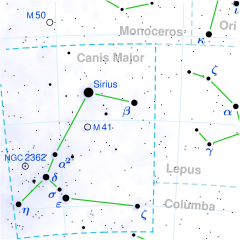Eta Canis Majoris
| Observation data Epoch J2000 Equinox J2000 |
|
|---|---|
| Constellation | Canis Major |
| Right ascension | 07h 24m 05.70228s |
| Declination | –29° 18′ 11.1798″ |
| Apparent magnitude (V) | 2.450 |
| Characteristics | |
| Spectral type | B5 Ia |
| U−B color index | −0.708 |
| B−V color index | −0.087 |
| Variable type | α Cyg |
| Astrometry | |
| Radial velocity (Rv) | 41.1 km/s |
| Proper motion (μ) |
RA: −4.14 mas/yr Dec.: 5.81 mas/yr |
| Parallax (π) | 1.64 ± 0.40mas |
| Distance | approx. 2,000 ly (approx. 600 pc) |
| Absolute magnitude (MV) | -7.0 |
| Details | |
| Mass | 19.19 ± 1.15 M☉ |
| Radius | 56.3 R☉ |
| Luminosity | 105,442 L☉ |
| Temperature | 15,000 K |
| Rotational velocity (v sin i) | 50 km/s |
| Other designations | |
| Database references | |
| SIMBAD | data |
Eta Canis Majoris (η Canis Majoris, abbreviated Eta CMa, η CMa), also named Aludra, is a star in the constellation of Canis Major. Since 1943, the spectrum of this star has served as one of the stable anchor points by which other stars are classified.
η Canis Majoris (Latinised to Eta Canis Majoris) is the star's Bayer designation.
The traditional name Aludra originates from the Arabic: العذراء al-adhraa 'the virgin'. This star, along with Epsilon Canis Majoris (Adhara), Delta Canis Majoris (Wezen) and Omicron2 Canis Majoris (Thanih al Adzari), were Al ʽAdhārā (العذاري), 'the Virgins'. In 2016, the International Astronomical Union organized a Working Group on Star Names (WGSN) to catalog and standardize proper names for stars. The WGSN's first bulletin of July 2016 included a table of the first two batches of names approved by the WGSN; which included Aludra for this star.
In Chinese, 弧矢 (Hú Shǐ), meaning Bow and Arrow, refers to an asterism consisting of Eta Canis Majoris, Delta Canis Majoris, HD 63032, HD 65456, Omicron Puppis, k Puppis, Epsilon Canis Majoris, Kappa Canis Majoris and Pi Puppis. Consequently, Eta Canis Majoris itself is known as 弧矢二 (Hú Shǐ èr, English: the Second Star of Bow and Arrow.)
...
Wikipedia

